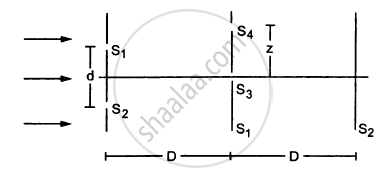Advertisements
Advertisements
प्रश्न
Obtain the conditions for the bright and dark fringes in diffraction pattern due to a single narrow slit illuminated by a monochromatic source.
Explain clearly why the secondary maxima go on becoming weaker with increasing.
उत्तर

Consider a point P on the screen at which wavelets travelling in a direction making angle θ with CO are brought to focus by the lens. The wavelets from points A and B will have a path difference equal to BN.
From the right-angled ΔANB, we have
BN = AB sinθ
BN = a sinθ …(1)
Suppose BN = λ and θ = θ1
Then, the above equation gives
λ = a sin θ1
`sin theta_1 = lambda/a ........ (2)`
Such a point on the screen will be the position of first secondary minimum.
If BN = 2λ and θ= θ2, then
2λ = a sin θ2
`sin theta_2 = (2lambda)/a .......... (3)`
Such a point on the screen will be the position of second secondary minimum. In general, for nth minimum at point P,
`sintheta_n = (nlambda)/a ........ (4)`
If yn is the distance of the nth minimum from the centre of the screen, then from right-angled ΔCOP, we have
`tantheta_n =(OP)/(CO)=y_n/D .............. (5)`
In case θn is small, sin θn ≈ tan θn
∴ Equations (iv) and (v) give
`(y_n)/D = (nlambda)/a`
`y_n = (nlambdaD)/a`
If `BN = (3lambda)/2`and θ = θ1′, then from equation (i), we have
`sintheta_1^' = (3lambda)/(2a)`
Such a point on the screen will be the position of the first secondary maximum. Corresponding to path difference,
`BN =(5lambda)/2`and θ = θ ′2, the second secondary maximum is produced
In general, for the nth maximum at point P,
`sintheta_n^' = ((2n+1)lambda)/(2a) .............. (6)`
If is the distance of nth maximum from the centre of the screen, then the angular position of the nth maximum is given by,
`tantheta_n^' = (y_n)/a ....... (7)`
In case θ′n is small,
sin θ’n ≈ tan θ’n
`y_n^' = ((2n+1)lambdaD)/(2a)`
For n = 1,
`theta' = (3lambda)/(2a)`(From eq(6), small angle approximation, `sin theta' =theta' = ((2n+1)lambda)/(2a)`
This angle is midway between two of the dark fringes. Divide the slit into three equal parts. If we take the first two third part of the slit the path difference between the two ends would be,
`2/3 a xx theta' = lambda`
The first two third is divided into two halves which have path difference `lambda/2`. The contribution due to these two halves is 180° out of phase and gets cancel. Only the remaining one third part of the slit contributes to the intensity at a point between the two minima which will be much weaker than the central maxima. Thus with increasing n the intensity of maxima gets weaker.
संबंधित प्रश्न
When monochromatic light is incident on a surface separating two media, the reflected and refracted light both have the same frequency as the incident frequency.
'Two independent monochromatic sources of light cannot produce a sustained interference pattern'. Give reason.
When light travels from a rarer to a denser medium, the speed decreases. Does this decrease in speed imply a reduction in the energy carried by the wave?
What kind of fringes do you expect to observe if white light is used instead of monochromatic light?
Monochromatic light of frequency 5.0 × 1014 Hz is produced by a laser. The power emitted is 3.0 × 10–3 W. Estimate the number of photons emitted per second on an average by the source ?
When monochromatic light travels from a rarer to a denser medium, explain the following, giving reasons:
(i) Is the frequency of reflected and refracted light same as the frequency of incident light?
(ii) Does the decrease in speed imply a reduction in the energy carried by light wave?
If a monochromatic source of light is replaced by white light, what change would you observe in the diffraction pattern?
Consider the situation shown in the figure. The two slits S1 and S2 placed symmetrically around the central line are illuminated by a monochromatic light of wavelength λ. The separation between the slits is d. The light transmitted by the slits falls on a screen ∑1placed at a distance D from the slits. The slit S3 is at the central line and the slit S4 is at a distance z from S3. Another screen ∑2 is placed a further distance D away from ∑1.Find the ratio of the maximum to minimum intensity observed on ∑2 if z is equal to

(a) \[z = \frac{\lambda D}{2d}\]
(b) \[\frac{\lambda D}{d}\]
(c) \[\frac{\lambda D}{4d}\]
Answer the following question.
In the diffraction due to a single slit experiment, the aperture of the slit is 3 mm. If monochromatic light of wavelength 620 nm is incident normally on the slit, calculate the separation between the first order minima and the 3rd order maxima on one side of the screen. The distance between the slit and the screen is 1.5 m.
Monochromatic light of wavelength 600 nm is incident from the air on a water surface. The refractive index of water is 1.33. Find the
- wavelength,
- frequency and
- speed, of reflected and refracted light.
